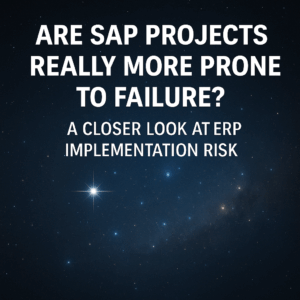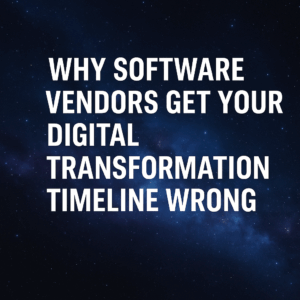PROSCI certification is one of the best-known credentials for organizational change management practitioners. While this and other certification programs provide a strong foundation of concepts and tools, digital transformation projects have some unique challenges that require additional depth and experience.
Table of Contents
ToggleDoes PROSCI certification live up to the hype?
I recently brought this question to LinkedIn, which generated quite a bit of comments (you can read the post and add your comments here).Aside from the question of how important certification is relative to hands-on transformation experience, there are a number of things to consider when it comes to change management on digital transformation projects. These are lessons and battle scars that can’t be taught in the classroom.
(Full disclaimer: Although I have over 20 years of organizational change management experience on digital transformation and ERP implementation engagements, I am not PROSCI certified as of yet. Many of our organizational change management consultants at Third Stage, however, are PROSCI certified).
Here are a few examples of organizational change challenges to expect on your digital transformation project. Not all of these lessons can be effectively taught in a PROSCI certification or classroom setting.
Unintended resistance to change
I have found that most employees in most organizations don’t intentionally resist change. Most aren’t out to sabotage or derail the initiative. But once you start talking about taking away that awesome spreadsheet they use to run the business, the fear sets in and takes over. As the graphic below visualizes, more obvious intentional change is just the tip of the iceberg. The more common – and harder to pinpoint and address – resistance is much subtler. Though subtle, these unintentional root causes of resistance are much more powerful than the intentional variety.
Impacts to employee jobs, roles, and responsibilities
Any sort of ERP implementation or digital transformation entails changes to people’s jobs. Some are direct, as is the example above of losing a spreadsheet. Some is indirect, such as when warehouse staff realize different picking forms and shipping labels from new technology. Whatever the examples, we find that impact to job roles is much more extensive than most clients expect.
This is true whether you are in the midst of an SAP implementation or more isolated technology deployment. Regardless of the software you’re deploying, don’t fall into the “this won’t be that big a deal for our employees” mindset trap.
Changes to organizational design
In addition to job impacts, organizational structures and reporting relationships typically change (or should change) during a digital transformation. Larger organizations often use these initiatives as enablers of standardization of business processes or deploying shared services models. Smaller organizations often use them as an opportunity to scale their operations for growth.
Both sides of the spectrum – and everywhere in between – need to focus on designing that future to-be organizational state to fully realize potential business benefits. This is an area that is commonly glossed over by digital transformation teams, consultants, and organizational change practitioners. I am not sure if this is an area covered in PROSCI certification courses.
The need to optimize business benefits
Most ERP implementations and digital transformations fail to deliver expected business benefits. This is largely due to failure in the points above. In order to make organizational change management less “fluffy” and more pragmatic, it needs to tie to tangible business benefits.
For example, if you are deploying a communication plan to enable business process efficiencies, results should be measured. This is the only way to truly tell if your organizational change efforts are effective or not. Adding a more analytical dimension is one of the ways that our view of organizational change management tends to differ from PROSCI certification and other change methodologies.
You can’t always get what you want
Deploying off-the-shelf software is painful for employees, especially when they’re used to getting everything they want from that highly customized legacy system. For years, they’ve grown accustomed to the software conforming to their needs and wants. Now, you’re telling them they have to do a 180 and conform to new technology.
If your intent is to minimize customization, then you had better invest heavily in organizational change management. High customization is often a symptom of a deeper root cause triggered by resistance to change. Deploying an effective organizational change strategy and plan will help mitigate the risk of software customization.
Where PROSCI certification fits in
Some of these concepts may or may not be touched upon on PROSCI certification and other classroom settings. But, they are very important keys to the success of your organizational change program and overall digital transformation.
The lesson here is to ensure that you don’t rely too much on certifications and other credentials that look good on paper but are no substitute for the real-world experience associated with these types of transformations. Training and certifications are good starting points that can’t hurt to have, but there is a lot more to digital transformation than can be taught academically.





